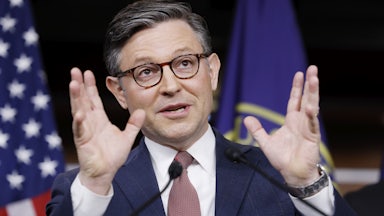Stop me if you’ve heard this one before: In the wake of a grueling battle over lifting the debt ceiling in 2011, the credit rating agency Standard & Poor’s downgraded the nation’s credit rating for the first time, reducing the prized AAA rating for the world’s largest economy to one notch below, at AA+. The agency cited “political brinkmanship” as its primary motivator for the downgrade, demonstrating that “the effectiveness, stability, and predictability of American policymaking and political institutions have weakened.”
This week, amid tense negotiations between President Joe Biden and House Republicans over raising the debt limit, Fitch Ratings placed its AAA credit rating for the United States on a negative watch—and it once again highlighted the dreaded b-word. “The brinkmanship over the debt ceiling, failure of the U.S. authorities to meaningfully tackle medium-term fiscal challenges that will lead to rising budget deficits and a growing debt burden signal downside risks to U.S. creditworthiness,” the agency said. Fitch warned that, if default occurred, affected securities could be downgraded to a D, with other Treasury bills downgraded to a CCC or C.
Fitch expected that the country would lift its borrowing cap before the so-called “X date,” the day on which the U.S. defaults on its debts, which Treasury Secretary Janet Yellen believes could occur as early as June 1. But the uncertainty further highlights the dire consequences of the current impasse itself.
Let’s recall that the 2011 S&P downgrade happened days after Congress voted to raise the debt ceiling, so merely achieving and voting on a deal in the coming days would not necessarily avert a similar situation. At the time, S&P was concerned about the apparent political unwillingness to quickly and easily pay the country’s debts but also the rapid pace at which the U.S. is accumulating those debts, running deficits of more than $1 trillion annually. Rachel Snyderman, the senior associate director for economic policy at the Bipartisan Policy Center, said that situation demonstrates how instability can rattle the markets even without explicit default.
“The United States, the leader of the global economy and the holder of the world’s reserve currency, could be in a situation where enough uncertainty over our fiscal challenges warrants a credit downgrade,” Snyderman said. “The markets prefer certainty. They don’t like uncertainty, and they don’t like fear.”
While undoubtedly serious, interpreting credit ratings can be a bit esoteric, so let’s take a minute to roll through the basics. A credit rating is an assessment of creditworthiness—that is, the likelihood that a borrower will default on their debts, and their worthiness of receiving new credit. On an individual level, credit ratings are scored on a numerical scale by credit bureaus like Equifax, Experian, and TransUnion.
On an institutional and sovereign level, credit ratings are typically issued on a letter-based scale from AAA to D, and are determined by agencies paid by the organizations and entities they are rating. Three agencies control 95 percent of the market: S&P, Fitch, and Moody’s. A sovereign credit rating is an assessment of a country’s creditworthiness, indicating the level of risk associated with lending to a certain nation. (While the ratings agencies are often viewed as near-infallible oracles, they are not without some controversy, and many believe they played a role in the 2008 economic collapse.)
Still with me? Now, let’s review why sovereign credit ratings are important: A strong rating makes investments in a country’s government bonds more likely and keeps interest rates lower. As I’ve written before, U.S. debt is considered to be a safe asset, meaning that Treasury securities are generally traded at a premium with lower interest rates. Previous debt ceiling showdowns have seen increases in interest rates, most recently in 2021, but also in 2011, 2013 and 2017. The higher interest rates resulting from the 2011 and 2013 debt ceiling crises bumped borrowing costs by hundreds of millions of dollars.
If the country’s credit were to be downgraded yet again, this would result in immediate “increased yields on Treasury securities,” Snyderman said, with investors demanding higher premiums. “When we see higher yields on the short-term securities, that immediately increases the U.S. government’s borrowing costs, which we know are footed by American taxpayers when we have to service our debt,” she continued.
Mark Zandi, the chief economist at Moody’s Analytics, also noted that other bonds and debt are “implicitly backstopped” by the federal government, as are many institutions—for example, major banks such as J.P. Morgan Chase, mortgage financing companies like Fannie Mae and Freddie Mac, and municipal governments. “If the U.S. government got downgraded, that would set off a cascade of downgrades because those entities are backstopped by the federal government. And that sends, obviously, a very strong signal to investors,” Zandi told me. (While a subsidiary of Moody’s Corporation, Moody’s Analytics is not involved with credit rating determinations.)
Zandi warned that investors might be forced to sell their bonds at a loss, which would in turn lead them to sell more bonds to cover those losses, creating a kind of “doom loop.” “At the same time that this is all going on, interest rates are rising, stock prices are falling very rapidly,” he said. “So you really don’t want to go down that path. That’s a very dark path.”
Although the country is still at least a week away from default, mortgage rates are already rising amid the deadlock over the debt ceiling. Stocks tumbled in the wake of the 2011 S&P downgrade, which would likely occur again if another agency downgraded the U.S. credit rating in the coming weeks.
But William Foster, senior vice president and senior credit officer of the bond credit ratings business of Moody’s, told CNN this week that the agency remains “confident” that the U.S. will not default on its debts, and thus has not changed its outlook to negative. Foster also said that if the U.S. continues to pay its debts and interest, while delaying other payments such as Medicare and Social Security benefits, Moody’s would not consider that a default. While prioritizing payments to bondholders would be “one step closer to default,” he continued, missing an interest payment would definitely result in a credit downgrade.
As two of the three major credit rating agencies still rate the U.S. to be AAA—or Aaa, in Moody’s terminology—investors generally consider the country to bear that prized triple-A status. Depending on the agency, roughly 10 to 12 countries can currently boast the AAA rating. Downgrading the U.S. rating would mean that it is considered less stable than countries like Germany, Singapore, and Australia.
It’s difficult to predict the long-term ramifications of an additional credit downgrade, but Snyderman said that costs would continue to accrue, “because many of the securities issued at elevated rates remain outstanding and accruing interest for several years.” Even after this particular debt limit impasse is resolved—assuming that it is resolved—those accrued costs would be paid for years to come.
But experts hope that the warning by Fitch, and the memory of the S&P downgrade 12 years ago, will encourage House Republicans and the president to reach a deal on the debt limit before another downgrade can occur.
“Hopefully, this is all just an intellectual exercise,” Zandi said.










